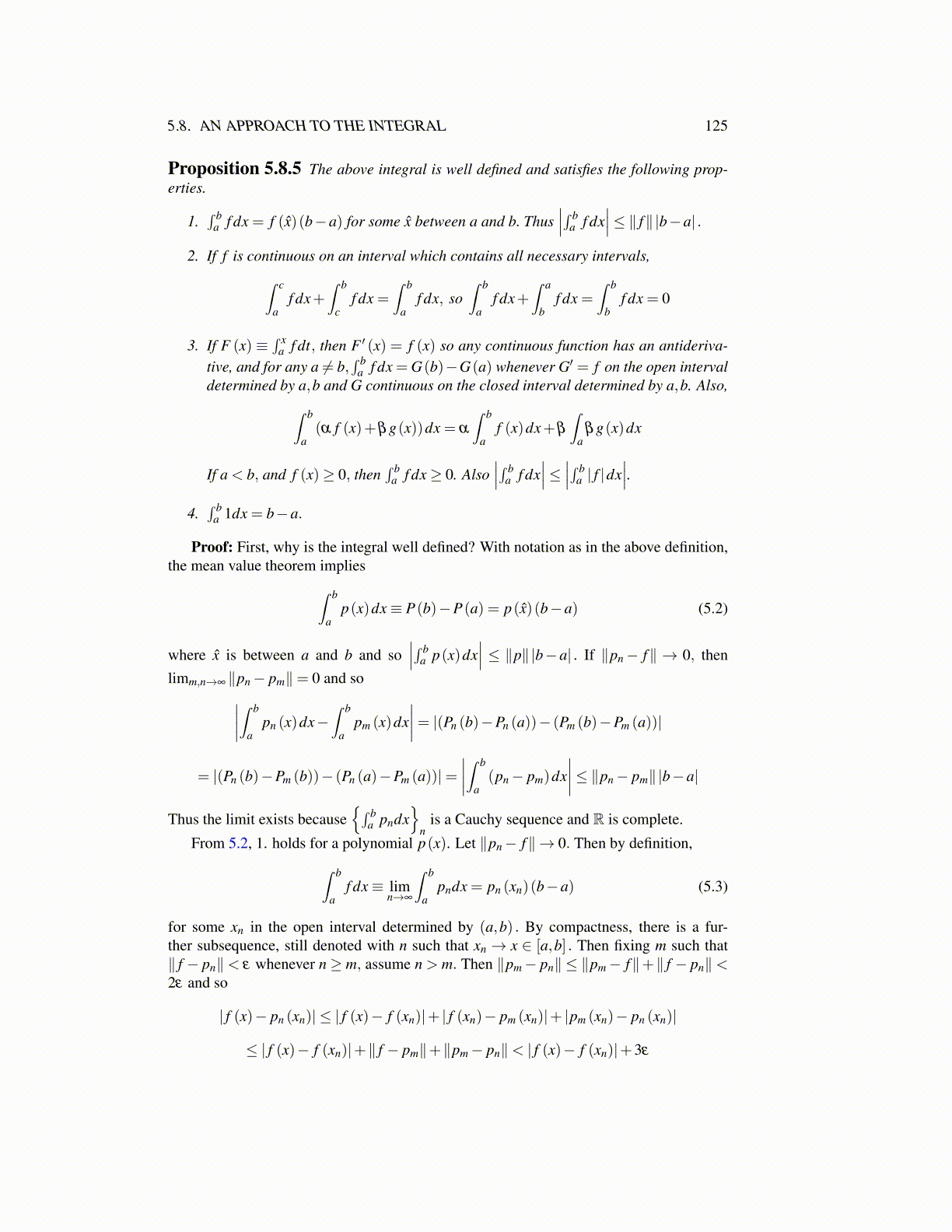
5.8. AN APPROACH TO THE INTEGRAL 125
Proposition 5.8.5 The above integral is well defined and satisfies the following prop-erties.
1.∫ b
a f dx = f (x̂)(b−a) for some x̂ between a and b. Thus∣∣∣∫ b
a f dx∣∣∣≤ ∥ f∥|b−a| .
2. If f is continuous on an interval which contains all necessary intervals,∫ c
af dx+
∫ b
cf dx =
∫ b
af dx, so
∫ b
af dx+
∫ a
bf dx =
∫ b
bf dx = 0
3. If F (x) ≡∫ x
a f dt, then F ′ (x) = f (x) so any continuous function has an antideriva-tive, and for any a ̸= b,
∫ ba f dx = G(b)−G(a) whenever G′ = f on the open interval
determined by a,b and G continuous on the closed interval determined by a,b. Also,∫ b
a(α f (x)+βg(x))dx = α
∫ b
af (x)dx+β
∫a
βg(x)dx
If a < b, and f (x)≥ 0, then∫ b
a f dx≥ 0. Also∣∣∣∫ b
a f dx∣∣∣≤ ∣∣∣∫ b
a | f |dx∣∣∣.
4.∫ b
a 1dx = b−a.
Proof: First, why is the integral well defined? With notation as in the above definition,the mean value theorem implies∫ b
ap(x)dx≡ P(b)−P(a) = p(x̂)(b−a) (5.2)
where x̂ is between a and b and so∣∣∣∫ b
a p(x)dx∣∣∣ ≤ ∥p∥|b−a| . If ∥pn− f∥ → 0, then
limm,n→∞ ∥pn− pm∥= 0 and so∣∣∣∣∫ b
apn (x)dx−
∫ b
apm (x)dx
∣∣∣∣= |(Pn (b)−Pn (a))− (Pm (b)−Pm (a))|
= |(Pn (b)−Pm (b))− (Pn (a)−Pm (a))|=∣∣∣∣∫ b
a(pn− pm)dx
∣∣∣∣≤ ∥pn− pm∥|b−a|
Thus the limit exists because{∫ b
a pndx}
nis a Cauchy sequence and R is complete.
From 5.2, 1. holds for a polynomial p(x). Let ∥pn− f∥→ 0. Then by definition,∫ b
af dx≡ lim
n→∞
∫ b
apndx = pn (xn)(b−a) (5.3)
for some xn in the open interval determined by (a,b) . By compactness, there is a fur-ther subsequence, still denoted with n such that xn → x ∈ [a,b] . Then fixing m such that∥ f − pn∥< ε whenever n≥ m, assume n > m. Then ∥pm− pn∥ ≤ ∥pm− f∥+∥ f − pn∥<2ε and so
| f (x)− pn (xn)| ≤ | f (x)− f (xn)|+ | f (xn)− pm (xn)|+ |pm (xn)− pn (xn)|
≤ | f (x)− f (xn)|+∥ f − pm∥+∥pm− pn∥< | f (x)− f (xn)|+3ε